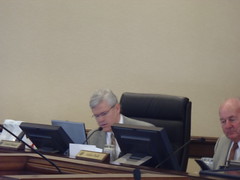 Lowndes County Commissioners had a small amount of open discussion about
the proposed changes to the zoning code related to Moody Air Force Base
at
their Work Session this morning.
However, most of the discussion was not about the changes currently proposed,
which the County Planner once again explicitly linked to a rezoning case
on the same agenda.
At least they discussed tabling the zoning code changes
until there could be more discussion.
They did not, however, say they would make drafts available to the public
or invite the public to discuss those drafts.
Lowndes County Commissioners had a small amount of open discussion about
the proposed changes to the zoning code related to Moody Air Force Base
at
their Work Session this morning.
However, most of the discussion was not about the changes currently proposed,
which the County Planner once again explicitly linked to a rezoning case
on the same agenda.
At least they discussed tabling the zoning code changes
until there could be more discussion.
They did not, however, say they would make drafts available to the public
or invite the public to discuss those drafts.
County Planner Jason Davenport introduced agenda item 7.d. TXT-2012-02 MAZ II Residential Density:
This text amendment is part of the response to some of the questions that were raised with the additional rezoning. At the end of the day what this text amendment is going to do is to take that very outer blue color, the lightest color, which is the MAZ-3, and recommend change the zoning to 1 acre. Currently it’s 2 and a half acres.
He mentioned they missed the 30 day requirement to inform Moody AFB by about a week, but Moody responded anyway. Hm, that’s not what he said to the Planning Commission; there he said they had allowed 31 days.
Commissioner Richard Raines said he’d prefer to table this amendment until next year, because:
I think there are other issues that we’ve discussed related to MAZ. If you have a mobile home and it becomes unlivable, under the restrictions you can’t replace it….
Chairman Ashley Paulk responded that he didn’t have a problem with that, and:
Continue reading










